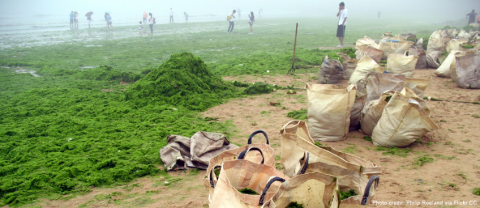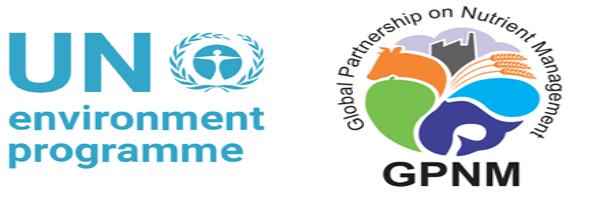
19 August 2015 (China) - China has recently experienced the influx of thousands of tonnes of the ‘green tide’ macro algae at one of the most popular seaside tourist attractions in the eastern Chinese province of Shandong. The algal bloom washed in from the Yellow Sea, a marginal sea of the Pacific Ocean located between mainland China and the Korean Peninsula. The sea’s name derives from the sand particles from Gobi Desert sand storms that turn the surface of the water golden yellow.
Tourists have been flocking to Qingdao beaches to witness and swim through the expansive algal mats along the shore. There may be a combination of several factors that cause these extreme events caused by the rapid growth of the algae; these include, warmer summer seas perhaps linked to climate change, that are enriched by phosphate and nitrate nutrients from industrial pollution, sewage and fertilizer runoff, as well as the expansion of seaweed farming along the coast.
Enormous macro algal blooms are experienced annually and the Chinese Government has employed military staff, volunteers and other county workers to clean up. Every year, approximately 20,000 tonnes of the seaweed are cleared from the beaches. The thick slime nearly caused havoc at the 2008 Olympic Games, which were held in Beijing, as Qingdao was chosen to host the sailing events.
On the other hand, the Chinese Government has facilitated the use of the thousands of tonnes of algae collected to produce animal feed and fertilizer, once dried. Algae can be used as bio-fertilizers and soil conditioners given their usefulness in restoring the soil's nutrient cycle, contributing organic matter and enhancing soil health and productivity in general.
The Global Partnership on Nutrient Management (GPNM) which is hosted by the Global Programme of Action for the Protection of the Marine Environment from Land-based Activities (GPA) is a response to this ‘nutrient challenge’ – how to reduce the amount of excess nutrients in terrestrial, freshwater, coastal and marine ecosystems. The GPNM reflects a need for strategic, global advocacy to trigger governments and stakeholders, countries and stakeholders in moving towards lower nitrogen and phosphorous inputs from human activities.
For more information, contact:
Christopher Cox, Programme Officer, Programme Officer, Global Programme of Action for the Protection of the Marine Environment from Land-Based Activities (GPA): Christropher.Cox@unep.org.
